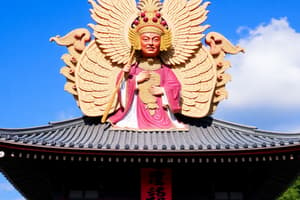Podcast
Questions and Answers
What does the word Shintō literally mean?
What does the word Shintō literally mean?
- The way of nature
- The way of ancestors
- The way of divine power (correct)
- The way of Buddha
Which major religion was introduced into Japan in the 6th century CE, leading to the need to distinguish indigenous beliefs?
Which major religion was introduced into Japan in the 6th century CE, leading to the need to distinguish indigenous beliefs?
- Christianity
- Islam
- Buddhism (correct)
- Hinduism
What distinguishes Shrine Shintō from Sect Shintō and Folk Shintō?
What distinguishes Shrine Shintō from Sect Shintō and Folk Shintō?
- It has been present throughout Japanese history (correct)
- It is only practiced in personal life
- It is not connected to Japanese values
- It has official sacred scriptures
What aspect of Shintō is more noticeable in the social life and personal motivations of the Japanese people?
What aspect of Shintō is more noticeable in the social life and personal motivations of the Japanese people?
Which of the following statements accurately describes Shintō beliefs?
Which of the following statements accurately describes Shintō beliefs?
How is Shintō primarily connected with the Japanese people's ways of thinking and acting?
How is Shintō primarily connected with the Japanese people's ways of thinking and acting?
Which type of Shinto is described as having no formal organizational structure nor doctrinal formulation, but is centered in the veneration of small roadside images and in the agricultural rites of rural families?
Which type of Shinto is described as having no formal organizational structure nor doctrinal formulation, but is centered in the veneration of small roadside images and in the agricultural rites of rural families?
Which form of Shinto is described as a relatively new movement consisting of 13 major sects that originated in Japan around the 19th century and several others that emerged after World War II?
Which form of Shinto is described as a relatively new movement consisting of 13 major sects that originated in Japan around the 19th century and several others that emerged after World War II?
What is the relationship between Shinto and the Japanese Imperial family described in the text?
What is the relationship between Shinto and the Japanese Imperial family described in the text?
What is the relationship between Shinto and Confucianism, Daoism, and yin-yang philosophy?
What is the relationship between Shinto and Confucianism, Daoism, and yin-yang philosophy?
What is described as the "primary Yayoi religious phenomena"?
What is described as the "primary Yayoi religious phenomena"?
What is described as the "constituent unit of society" in ancient times in Japan?
What is described as the "constituent unit of society" in ancient times in Japan?
Flashcards are hidden until you start studying




